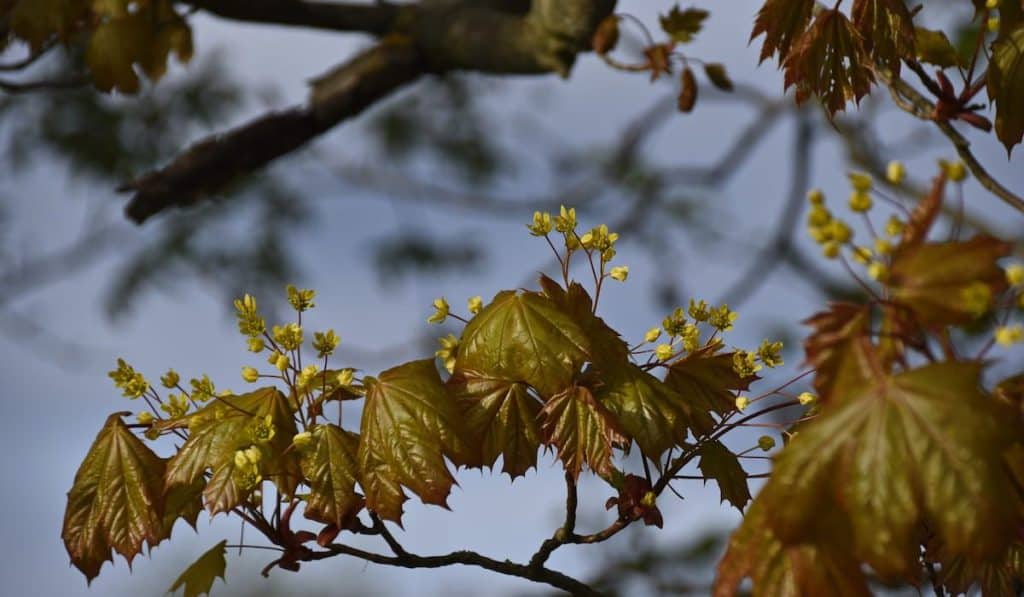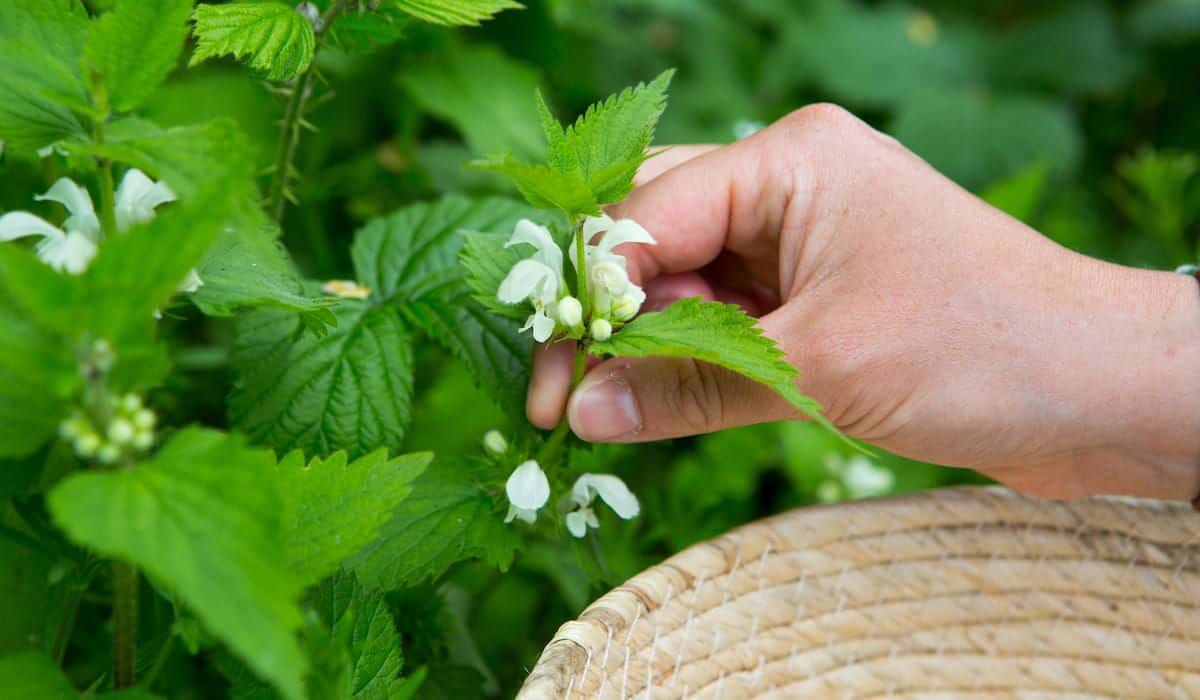You can eat leaves from many trees, yes! Just be aware that some tree leaves are quite toxic, too. Before you go foraging leaves, you will absolutely need to be able to tell the difference (some toxic tree leaves can even prove fatal).
On the other hand, edible tree leaves can be added to salads, stir-fries, smoothies, and countless other unique and tasty foods. Learn some of the most common edible and non-edible kinds of tree leaves, below!
What Can You Use Tree Leaves For?
Believe it or not, many types of tree leaves make delicious additions to salads, stir-fries, vegetable wraps, egg rolls, and more!
Certain leaves are particularly fragrant, making them perfect for tea. Others have special health benefits and can be dried and made into a nutritious powder (which you can then add to smoothies, baked goods, and the like).

What Kinds of Tree Leaves Can You Eat?
You’d be surprised how many, but most are best picked in the spring. You’d be surprised at how many trees have edible leaves. The main limitation is that most should be picked in the springtime when they are the gentlest on the stomach and have the sweetest flavor.
Here are some of the most common edible tree leaves that you can forage on your own:
American Beech
American Beech Trees have beautiful gray-silver bark that fits smoothly, like skin or leather. They can reach 50 to 70-feet tall and are found everywhere in Eastern North America.
The leaves are oblong, with a pointed tip. They are slightly serrated and have straight veins lining them on either side (like feathers).
American Beech Tree Leaves are best gathered in the spring when they are the sweetest and most tender. As they age, they will grow considerably tougher and more bitter!
American Linden Tree Leaves
The American Linden is a flowering tree with a thick, stocky trunk covered in highly-texture dark brown bark. You may also know it by its distinctive tiny, nectar-filled yellow flowers (which make for a lovely tea).
It reaches 60 to 80-feet tall, though younger trees can be as little as 10 feet, and they are found in the Northeastern and Midwest parts of North America.
The leaves of the Linden Tree have only very light veining and are thick and rounded and slightly heart shaped. They tend to be quite light in color, with a slightly pungent taste (which some have compared to asparagus).
Maple Tree Leaves
Maple Tree Leaves make it simple for you, as they are very distinctive and easy to identify. They are very roughly toothed, with 3-5 leaf points. In Autumn, they are renowned for their vibrant crimson color, and some varieties are orange or red year-round.
Maple Trees grow almost anywhere in Northern America but prefer North and Northeastern areas that are cooler.

As you would expect, young Maple leaves are quite sweet. The veins of the leaves are rather salty, and they have a barely perceptible Maple flavor!
Sassafras Tree Leaves
Sassafras Trees grow in Eastern North America. They are medium-sized trees with leaves that have one rounded main tooth and two teeth to either side (also known as lobes).
Sassafras is one of the key ingredients in root beer. The leaves are highly prized for their unique flavor, which is a mixture of lemon, anise, eucalyptus, and slight notes of root beer. They make for an aromatic tea and can also be used to add flavor to soups and salads.
Willow Tree Leaves
Did you know that all willow trees are edible? These tall, graceful trees can be found all throughout North America. They are one of the most recognizable trees, with long wands hanging from the uppermost branches. These are covered in tiny, oblong leaves that are pointed on each end.
Unfortunately, Willow leaves are extremely bitter and rather tough, making them unideal culinarily. They are primarily used in medicines and eaten plain only for survival purposes.
Spruce Tree Tips
Spruce trees are exceptionally recognizable, with short, blue-green needles that grow singularly (pine needles grow in twos). They grow primarily in Northern America.
In the spring, the ends of Spruce branches will create new growth that will be bright green in color. These are called Spruce tips, and they are extremely flavorful and tender. In fact, some will simply pop them in their mouths plain for enjoyment.
Spruce tips have notes of citrus and pines and make for lovely, fragrant teas. They can also be eaten in salads, made into unique candy, or added to baked goods, such as scones, bread, or cookies, to imbue them with subtle, woodsy flavor!
Pine and Fir Tree Needles
Pine and fir trees can be found all over the world and grow in abundance in North America. The trees are covered in distinctive needles, with curling, shell-like bark.
Pine and fir needles do not have a lot of substance, but they are full of flavor. They can be chewed for the juice or made into a bittersweet tea that smells like the forest itself. Some will also use them as a seasoning on baked fish or in soups.
Moringa Tree (Tree of Life) Leaves
You may have already heard of the Moringa Tree, also known as the Tree of Life, and its many culinary benefits. This drought-resistant tree grows worldwide and can be found only in the warmest and most humid areas in North America, such as Florida, California, Arizona, Texas, etc. The trees can reach 30 to 45-feet tall.
Moringa leaves are small, soft, round leaves that grow in 7 to 9-leaf clusters. They are chock-full of vital nutrients, including iron, protein, calcium, potassium, and vitamins C and A.
These leaves are prized for their nutty, spicy flavor. They are delicious in salads and soups. The leaves can even be dried and made into a powder for a nutrient-boost in cookies, bread, smoothies, soups, and more!
Mulberry Tree Leaves
Mulberry Trees are native to Asia and the more temperate areas of North America. They are best known for their dark, super-sweet and juicy fruits, which resemble oblong black raspberries. Less known is that the leaves are edible, too.
Mulberry Tree leaves are best enjoyed in the spring when they are new and just beginning to uncurl. They will become more bitter and upsetting to the stomach as they get older.
These leaves are thick and crunchy, and are great for adding texture to salads, stir-fries, veggie wraps, egg rolls, and more!
Hawthorne Tree Leaves
Hawthorne Trees grow in Europe, Eastern Asia, and North America. These trees have smooth, gray bark that develops fissures as they age, and pronged leaves that are somewhat similar to Mape leaves. They can reach anywhere between 15 to 30 feet.
Young Hawthorn leaves have many of the same benefits that the fruits and flowers do and are very good for the heart. They have an especially pleasant, sweet taste.
In England, they were eaten as often as lettuce, being referred to as the ‘salt and pepper’ or ‘bread and cheese’ of certain meals (such as salads).

What Types of Leaves from Trees are Non-Edible (Toxic)?
Poison Sumac Leaves
Considering its name, and that all parts of the plant are toxic, that the Poison Sumac has poisonous leaves is no shocker.
This is thanks to a toxin called urushiol, which causes severe digestive upset, breathing trouble, and worse. In fact, it can be fatal.
Even just contact with the skin will cause irritation and potentially an allergic reaction. To sum it up, this is a tree you’ll definitely want to avoid. Keep an eye for it in swampy, wooded places, like Texas, Florida, etc.!
Cherry Tree Leaves
While cherries are quite safe, all other parts of the Cherry Tree are poisonous. The leaves, seeds, and bark contain cyanogenic glycosides. These cause vomiting, dizziness, headaches, and other very unpleasant symptoms. It can even be fatal.
Luckily, Cherry Trees are quite easy to recognize, as they are beloved not only for their delicious, juicy fruit but also for their fluffy spring flowers. The bark is curled, and silver and the leaves are serrated, with red tips (these are a sort of gland).
Pacific Yew Tree Leaves
The Pacific Yew is an evergreen tree that looks a bit similar to a pine or fir. It is much more poisonous, and not to be mistaken, however. These trees grow in Southeast Alaska and are sparse throughout North America.
While the bark is edible, the leaves of the Pacific Yew contain an alkaloid toxin that attacks heart function. Consumption can cause heart trouble and even prove fatal. So, stick to the bark!
Australian Stinging Tree Leaves
Australian Stinging Trees are as unappealing for eating as the name makes them sound. They are covered in tiny, toxic spines, much like stinging nettle. It causes extreme pain when touched and the leaves are toxic. Only the fruit is edible.
Australian Stinging Trees are found in the Australian Rainforests. They have round leaves, similar to aspen leaves, and can grow up to a whopping 100 feet tall. Fortunately, you aren’t likely to mistake this one!
These are just some of the most common toxic tree leaves. Before sampling any leaves from any sort of tree, be sure to double-check that it is safe to eat. You can do this with a quick online search – it couldn’t be easier!
How to Forage Leaves from Trees Respectfully
When it comes to foraging leaves – or anything – respectfully, there are two key things you’ll need to remember. First, harvest with care, taking only a small amount from any single tree or one area.
Leave some behind for the tree and the wildlife – but don’t feel bad taking a few leaves for yourself, either!
Second, be careful of the land. Try not to go off-trail, and avoid stepping on any plants, moss, and so on. Never litter, and if you’re feeling like giving something back, you can pick up others’ litter. These are the two most important steps to becoming a responsible forager.
So, as you can see, some leaves are not only edible, but they are also even quite flavorful and nutritious.
Others are nothing short of deadly.
Make sure to do the necessary research before foraging tree leaves, so you’ve got the proper know-how!




